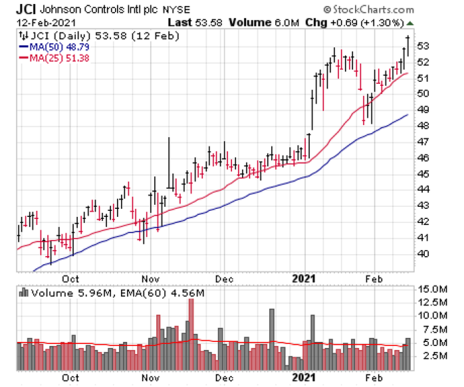The stock market added to its gains last week up for a second straight week with the S&P 500 up 1.2% while the Nasdaq jumped 1.7%. Of note, February expiration is upon us this week. And all three of our February positions (Alcoa, Kohl’s and Snap) are in great shape, and likely to expire for full profits. But rest assured I will send you a full breakdown of these positions on Friday morning prior to expiration.
Cabot Profit Booster 162
The stock market added to its gains last week up for a second straight week with the S&P 500 up 1.2% while the Nasdaq jumped 1.7%. Of note, February expiration is upon us this week. And all three of our February positions (Alcoa, Kohl’s and Snap) are in great shape, and likely to expire for full profits. But rest assured I will send you a full breakdown of these positions on Friday morning prior to expiration.
Continued market strength and rotation into more cyclical sectors leads me to this week’s Cabot Profit Booster recommendation. Here is the stock, and our covered call trade:
The Stock – Johnson Controls International plc (JCI)
Why the Strength
The pandemic put a significant dent in the market for commercial real estate last year, leaving offices vacant as the work-from-home movement became established. Johnson Controls is a major player in commercial and residential building supply, including fire detection, HVAC and refrigeration equipment.
While the company experienced a sharp drop in bookings during last year’s Covid-related shutdown, sales have since rebounded thanks to a new artificial intelligence-driven building control system. One indication of the rebound is a reported backlog of $9.5 billion (up 3%), as of Q1 2021.
In the latest quarter, Johnson Controls launched seven new offerings, most notably OpenBlue healthy buildings. Touted as the industry’s most comprehensive suite of connected solutions, it features data-driven AI technologies that facilitate enhanced interaction with buildings by creating intelligent, safe and dynamic environments—including a full suite of Covid-19 solutions—and billed as a way to get customers back to work as “safely and efficiently as possible.”
Also in fiscal Q1, per-share earnings improved by 8% from a year ago to 43 cents, while free cash flow was up 10% to over $400 million. Although sales declined 4%, the top line improved sequentially compared to last quarter’s 6% decline. The company reported higher demand for residential HVAC equipment in North America, as well as in its Asia Pacific and China markets. (Indeed, HVAC demand is expected to dramatically increase in Covid’s wake in the next 2-3 years.)
Looking ahead, management expects Q2 revenue to increase in the low-to-mid single-digit range, then ramp up significantly in the second half of the year (in line with estimates). We like the story.
Technical Analysis
After a waterfall decline from 43 to 23 in last year’s first quarter, JCI commenced a spirited recovery from those lows on the back of improved worldwide HVAC demand. There were a couple of bounces off the 50-day line last fall, followed by a springboard move to new highs in January. You could start small here or on pullbacks of a point or two. Stop — 47
The Covered Call Trade
Buy Johnson Controls International plc (JCI) Stock at 54, Sell to Open March 55 Strike Calls (exp. 3/19/21) for $1.25, or a Net Price of 52.75 or less
Static Return: $125 per covered call (2.37%)
Breakeven: 52.75
Covered Call Return (if assigned): $225 per covered call (4.27%)
Please note – JCI should pay a dividend of $0.26 per share, based on its past 10 quarterly payouts, although the dividend has not yet been declared. But if declared, we will collect the dividend as the owner of the covered call adding to our potential gains.
Also note, the stock and options prices will be moving throughout the day, so these prices are simply an approximation of prices that you should be able to achieve.
However, the important component of this equation is that the stock price paid, minus the premium received via the call sale, equals the Net Price, of 52.75 or less. (In this case 54 minus 1.25 = 52.75. Or another example is you could pay 53.75 for the stock and sell the call for 1.00, which also equals 52.75)
For every 100 shares of stock you buy, you can sell 1 call. For every 200 shares of stock you buy, you can sell 2 calls. And so on …
Open Positions
If our stop is hit, I will send an alert giving detailed instructions on how to exit the trade. But don’t get too worried about setting the stop. I will manage that for you.
The next Cabot Profit Booster issue will be published on February 23, 2021.


